The term “LGBTQI” may be familiar, but you might have seen “LGBTQI+” and wondered what the “+” at the end means. Language is constantly evolving, and this symbol seeks to reflect and celebrate the full diversity of sexual orientations, gender identities and expressions, and sex characteristics — not only those who identify as lesbian, gay, bisexual, transgender, queer or intersex. LGBTQI+ includes them all.
The “+” includes people who do not identify as either men or women and includes individuals who are attracted to many genders or to individuals regardless of gender. It also includes those who experience little to no sexual attraction to others and those who do not experience romantic attraction. [See a glossary of many LGBTQI+ terms.]
June is LGBTQI+ Pride Month and is filled with awareness campaigns and parades. June commemorates the 1969 Stonewall Uprising, when New York City Police raided a bar popular with the LGBTQI+ community and patrons resisted. The uprising created the opportunity for millions to press for full and equal civil rights for the LGBTQI+ community.

Equality Parade 2021 participants carry transgender (at left) and pansexual flags in Warsaw, Poland. (© Kornelia Kobiela/Shutterstock.com)
LGBTQI+ persons have made important contributions to their communities throughout human history. The way people have described themselves and their roles remain relevant today. For example:
- Some North American Indigenous groups use two-spirit as a term for Indigenous people who express both a masculine and a feminine sexual, gender or spiritual identity.
- In ancient Hawaiian tradition, the word māhū possessed tremendous cultural and spiritual value, referring to men who adopt feminine roles.
- Ancient Jewish thought identified six genders and discussed how Jewish laws would apply to them.
Jessica Stern is the U.S. special envoy to advance the human rights of LGBTQI+ persons. She works with governments, civil society organizations and the private sector to promote and protect equal respect for the human rights of the LGBTQI+ community worldwide.
“Very few governments in the world have made a commitment to the integration of LGBTQI+ human rights in their foreign policy,” Stern said. “The U.S. can be a source of hope and inspiration for others.”
Banner image: A participant in the 2017 Toronto Pride Parade holds a sign saying "I am asexual & I exist." (© Shawn Goldberg/Shutterstock.com)







COMMENTS0
LEAVE A COMMENT
TOP